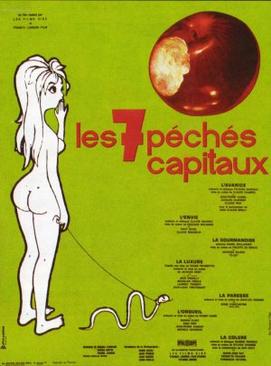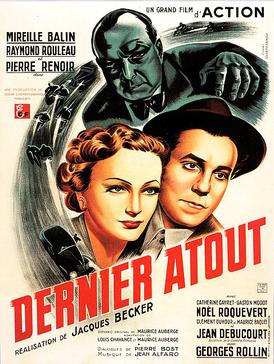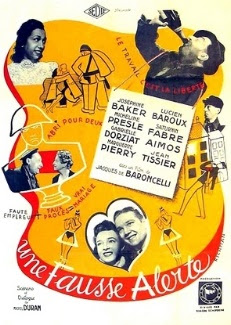
Jean Paul Gaultier is a French haute couture and prêt-à-porter fashion designer. He is described as an "enfant terrible" of the fashion industry and is known for his unconventional designs with motifs including corsets, marinières, and tin cans. Gaultier founded his eponymous fashion label in 1982, and expanded with a line of fragrances in 1993. He was the creative director for French luxury house Hermès from 2003 to 2010, and retired following his 50th-anniversary haute couture show during Paris Fashion Week in January 2020.
André Hunebelle was a French maître verrier and film director.

Micheline Presle was a French actress. She was sometimes billed as Micheline Prelle. Starting her career in 1937, she starred or appeared in over 150 films appearing first in productions in her native France and also in Hollywood during the era of Classical Hollywood Cinema, before returning again to Europe, especially French films from the mid-1960s until 2014.

Les Sept péchés capitaux is a 1962 French film composed of seven different segments, one for each of the seven deadly sins, each being by different directors and featuring different casts. At the time it served as a showcase for rising directors and stars, many of whom achieved later fame.

Venus Beauty Institute, also known as Venus Beauty, is a 1999 French romantic comedy. The story centers on three employees of a beauty parlor and their search for love and happiness. The film is directed by Tonie Marshall. It stars Nathalie Baye, Bulle Ogier, Samuel Le Bihan, Jacques Bonnaffé, Mathilde Seigner, Audrey Tautou, Robert Hossein, Claire Denis, Micheline Presle, Emmanuelle Riva and Elli Medeiros.

Napoléon is a 1955 French historical epic film directed by Sacha Guitry that depicts major events in the life of Napoleon.

Devil in the Flesh is a 1947 French romantic drama film directed by Claude Autant-Lara, based on the 1923 novel of the same name by Raymond Radiguet. The film stars Micheline Presle and Gérard Philipe, with Palau, Jean Varas, Jacques Tati, Denise Grey and Jean Debucourt in supporting roles.

Royal Affairs in Versailles is a 1954 French-Italian historical drama directed by Sacha Guitry. Described as "a historical film showing Versailles from its beginnings to the present day", it tells some episodes through portrayal of the personalities who lived in the Palace of Versailles. Its sister films are Napoléon (1955) and If Paris Were Told to Us (1956).

Edward and Caroline is a 1951 French comedy drama film directed by Jacques Becker and starring Daniel Gélin, Anne Vernon and Elina Labourdette. It was entered into the 1951 Cannes Film Festival. It was shot at the Billancourt Studios in Paris. The film's sets were designed by the art director Jacques Colombier.

Jean Chevrier was a French film actor and member of the Comédie-Française. He appeared in 50 films between 1936 and 1972. He was married to actress Marie Bell. At the end of his life, he was known as Jean-Claude Pascal's lover. He was buried alongside his wife at the Monaco Cemetery in Monaco.

Raymond Rouleau was a Belgian actor and film director. He appeared in more than 40 films between 1928 and 1979. He also directed 22 films between 1932 and 1981. Rouleau studied at the Royal Conservatory of Brussels, where he met Tania Balachova. They emigrated to Paris together and collaborated with a variety of directors at the cutting edge of French theatre, including Charles Dullin and Gaston Baty. They married in France and separated in 1940. He subsequently married the actress Françoise Lugagne.
Five Day Lover is a 1961 French sex comedy film directed and co-written by Philippe de Broca, starring Jean Seberg and Micheline Presle. It is based on the 1959 novel L'amant de cinq jours by Françoise Parturier. The film was entered into the 11th Berlin International Film Festival and nominated for the Golden Bear.

La Nuit fantastique is a 1942 French fantasy film directed by Marcel L'Herbier. It is regarded as one of the most successful films made in France during the German occupation.

Thirteen at the Table is a 1955 French comedy film directed by André Hunebelle and starring Micheline Presle, Fernand Gravey and Germaine Montero. It was shot at the Francoeur Studios in Paris. The film's sets were designed by the art director Lucien Carré. It is based on the 1953 play of the same name by Marc-Gilbert Sauvajon.
Françoise Lugagne (1914–1991) was a French stage, film and television actress. She was married to the Belgian actor Raymond Rouleau and appeared alongside him in the 1945 fashion house drama Paris Frills as his spurned love interest.

The Trump Card is a 1942 French crime film directed by Jacques Becker and starring Mireille Balin, Raymond Rouleau and Pierre Renoir.

The Big Flag is a 1954 French drama film directed by Jacques Pinoteau and starring Jean Chevrier, Marc Cassot and Marie Mansart. It was shot at the Photosonor Studios in Paris. The film's sets were designed by the art director René Moulaert. Location shooting took place on board the French cruiser Jeanne d'Arc at Brest.

The Lady of the Camellias is a 1953 French-Italian historical drama film directed by Raymond Bernard and starring Micheline Presle, Gino Cervi and Roland Alexandre. It is based on the 1848 novel of the same title by Alexandre Dumas. It was shot in Gevacolour at the Billancourt Studios in Paris and on location around the city. The film's sets were designed by the art director Léon Barsacq.

False Alarm is a 1940 romantic comedy drama film directed by Jacques de Baroncelli and starring Lucien Baroux, Micheline Presle, Josephine Baker and Saturnin Fabre The film's sets were designed by the art director Émile Duquesne and Eugène Lourié. It was filmed during the Phony War before the German Invasion. Delays to its release meant it was not given a full French premiere until 1945. It is also known as The French Way the alternative title it was later released under in the United States in 1952, with advertising heavily featuring American-born star Baker.
















